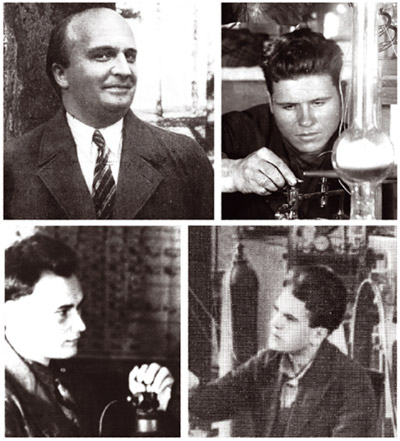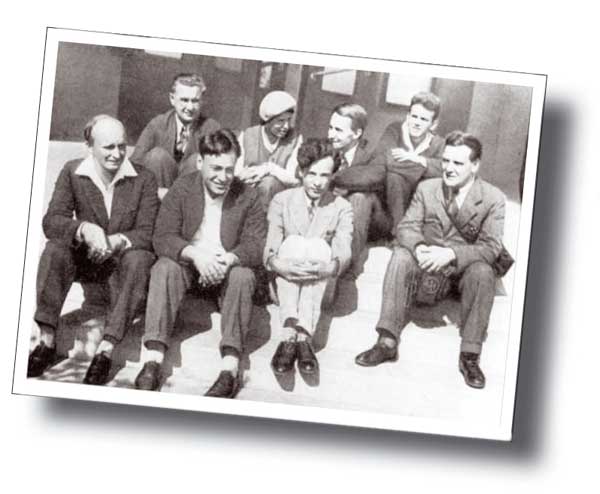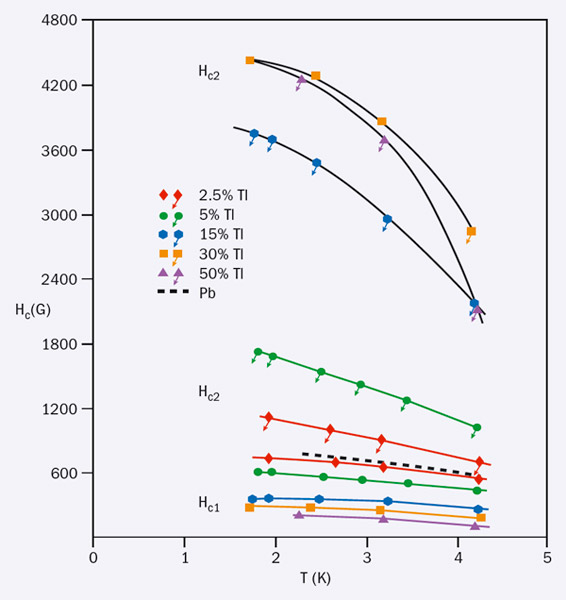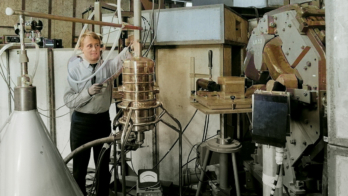The tragic tale of the first observations in Kharkov.

Image credit: A Shepelev.
Regular readers of CERN Courier are well aware that the LHC depends on some 10,000 magnets made of type II superconductor, which remains superconductive in high magnetic fields. Many will also recall that the era of superconducting magnets began 50 years ago when John “Gene” Kunzler and colleagues at Bell Telephone Laboratories showed that a primitive Nb3Sn wire could carry more than 1000 A/mm2 in a field of 8.8 T. What is much less well known is that the path to type II superconductors had already been demonstrated a quarter of a century earlier by Lev Shubnikov, Vladimir Khotkevich, Georgy Shepelev and Yuri Rjabinin in Kharkov (Shubnikov et al. 1936a, 1936b and 1937). So how was it that this understanding was lost for 25 years and rediscovered only by accident in 1961?
From the beginning
The huge value of superconducting wires for high-field magnets was clearly understood by Heike Kamerlingh Onnes, the discoverer of superconductivity. In his report submitted to the 3rd International Congress of Refrigeration in Chicago of 1913, he described his design for a 10 T superconducting solenoid. He had recently passed almost 500 A/mm2 through a lead wire, although his first attempt at a silk-insulated lead wire was not so successful, no doubt because of some “bad places in the wire” (Kamerlingh Onnes 1913). Sadly, just one year later, he found that pure-metal superconductors lose their superconductivity at a critical magnetic field, Hc, that is much less than 0.1 T. His interest then languished when the First World War intervened.
Work restarted in the 1920s, by which time laboratories in Leiden, Toronto, Oxford and Kharkov all had liquid helium and work on the superconductivity in metal alloys was taken up again. The initial results were complex because the loss of diamagnetism occurred at fields much lower than those at which resistance was restored. In the best cases, traces of superconductivity by transport were seen at almost 2 T. Kurt Mendelssohn in Oxford put forward the “sponge hypothesis”, which hypothesized that the small supercurrent densities observed at high fields were associated with a fine, filamentary network of tiny relative volume (Mendelssohn 1935). Because most samples had poorly controlled homogeneity and cold work state, metallurgical inhomogeneity was, indeed, a contributor to the large variation in properties.

This plausible but fundamentally and decisively wrong hypothesis was soon to get its rebuttal by the experiments on lead–indium and lead–thallium alloys made by Shubnikov’s group in Kharkov. This seminal work of 1936 was characterized by its use of well annealed single crystals that in principle completely invalidated the premise of the “sponge model”. The experiments showed three main features:
1. There is a critical alloy concentration, xc, below which alloys behave as pure superconductors with a full Meissner effect and abrupt loss of superconductivity at a critical field, Hc (figure 1a).
2. Increasing the alloy concentration beyond xc, for example from 0.8 to 2.5% by weight of Tl in figure 1b, drastically changes the equilibrium magnetic properties, separating the loss of superconductivity, which occurs at an increasingly higher critical field Hc2, from the onset of flux penetration at the lower critical field Hc1.
3. With increasing xc, Hc1 becomes smaller, while Hc2 grows larger (figure 2). Shubnikov realized, however, that the energy of the superconducting state in his well annealed, almost reversible (i.e. low current density) single crystals was almost independent of alloy content.

Image credit: UPhTI, Kharkov.
In all normal circumstances, the high quality of the Kharkov crystals, their evident homogeneity and above all the finding that their superconductivity must have been a bulk effect incapable of being explained by a small filament network should have undercut the sponge hypothesis and instigated much greater attention to the thermodynamic properties of the new type II superconducting state.
Regrettably, this discovery occurred against a backdrop of bitter conflict and human tragedy. Shubnikov’s friend Lev Landau, who was “held captive” by the “Mendelssohn sponge”, did not recognize this discovery either in 1936 or in 1950, when he and Vitaly Ginzburg created the phenomenological theory of superconductivity that, as Alexey Abrikosov later found, provided a beautiful description not just of the type I superconductors that they considered but also of the type II superconductivity discovered by Shubnikov. It is clear that their parameter κ describes perfectly the transition from type I to type II behaviour at the critical value 1√2. However, Landau still did not recognize the discovery by Shubnikov’s group, even though their results and the published paper were presented by Martin Ruhemann at the 6th International Congress of Refrigeration in The Hague in 1936. For reasons that appear quite mystifying in 2011, none of the scientists present either supported or continued the Kharkov work, even though a number of contemporary references cite it.
The real tragedy occurred a year later. Shubnikov, the director of the Low Temperature Laboratory in Kharkov, who had come under suspicion and been confined to the Soviet Union in 1936, was arrested in 1937 on charges of spying (the laboratory was well connected to Western laboratories, Shubnikov having spent several years in Leiden). He was summarily shot dead without any legal process. The following year, Landau was arrested and held in prison for a year, being released only on the advocacy of Pyotr Kapitza. The Soviet Union was experiencing a difficult time.
The dormant period
The results of Shubnikov and his co-workers remained generally unknown for another 25 years, even though Abrikosov drew attention to the work in the 1950s when he predicted the vortex state in high κ (>> 1/√2) superconductors. In his 2003 Nobel address describing his work explaining type II superconductivity, Abrikosov said: “I compared the theoretical predictions about the magnetization curves with the experimental results obtained by Lev Shubnikov and his associates on Pb–Tl alloys in 1937, and there was a very good fit” (Abrikosov 2004). However, as he has pointed out, his paper came out just as the Bardeen–Cooper–Schrieffer theory of superconductivity was published and all interest became focused on the superconducting mechanism, rather than on what some regarded as an esoteric vortex state. So work on high-field magnets lay dormant until the totally unexpected discovery by Kunzler’s group, which connected all of the disconnected sightings of high-field and high-current-density superconductivity that had been impossible to explain by the Mendelssohn sponge. Ted Berlincourt has written fine recollections of this fertile period in the 1950s when finally things began to gel (Berlincourt 1987).

After 1961, Shubnikov’s seminal role in this extraordinary advance in science and technology was finally recognized, in particular at the International Conference on the Science of Superconductivity held in Hamilton, New York, in 1963, where several speakers praised the research. The conference chair, John Bardeen, and the secretary, Roland Schmitt, stated formally in the proceedings: “It should be noted that our theoretical understanding of type II superconductors is due mainly to Landau, Ginsburg, Abrikosov and Gor’kov, and that the first definitive experiments were carried out as early as 1937 by Shubnikov” (Bardeen and Schmitt 1964). Soon after, future Nobel laureate Pierre-Gilles de Gennes introduced the designation the “Shubnikov phase” for the mixed-vortex state that is stable between Hc1 and Hc2 (de Gennes 1966). It is also the case that the first doctoral dissertation on type II superconductors was that written by G D Shepelev under Shubnikov’s guidance.
Finally, we may note that the long, 25-year period of 1936–1961, in which the sponge hypothesis held sway, was also a period in which many new superconductors – such as NbN and Nb3Sn – were discovered. Like the more recent discoveries of cuprates, organics, MgB2 and the new iron-based systems, all are type II superconductors. What might have been if only the poignant politics of the Soviet 1930s had not so tragically entwined the studies and fate of Shubnikov’s group in Kharkov?





